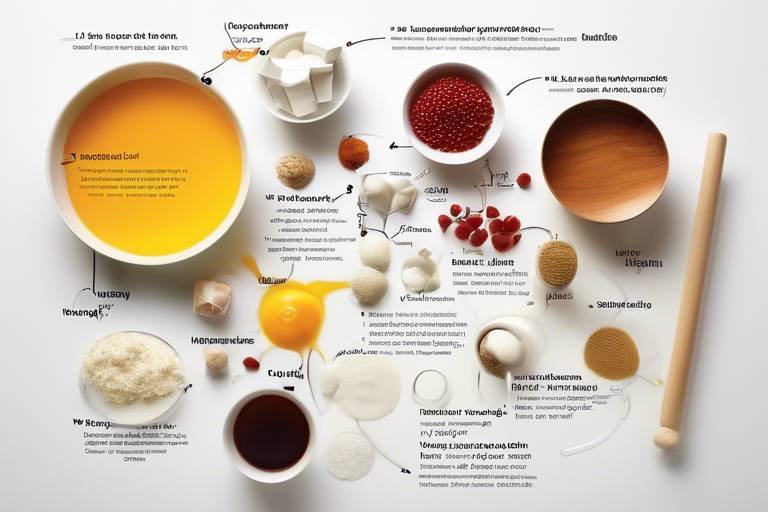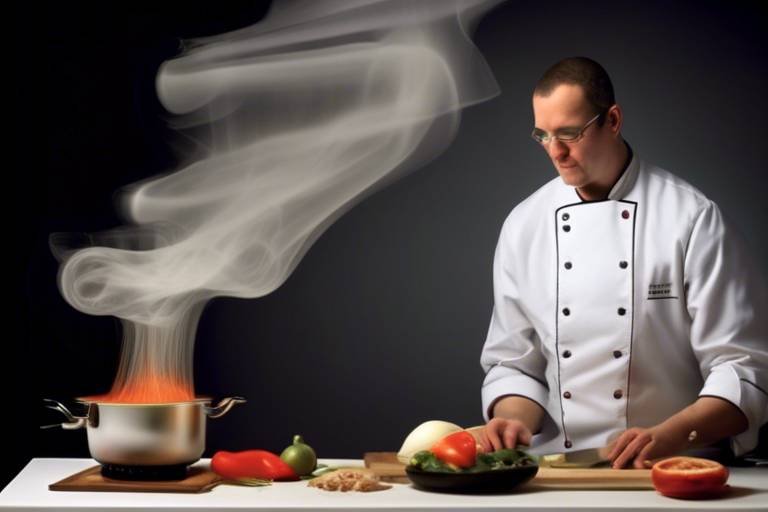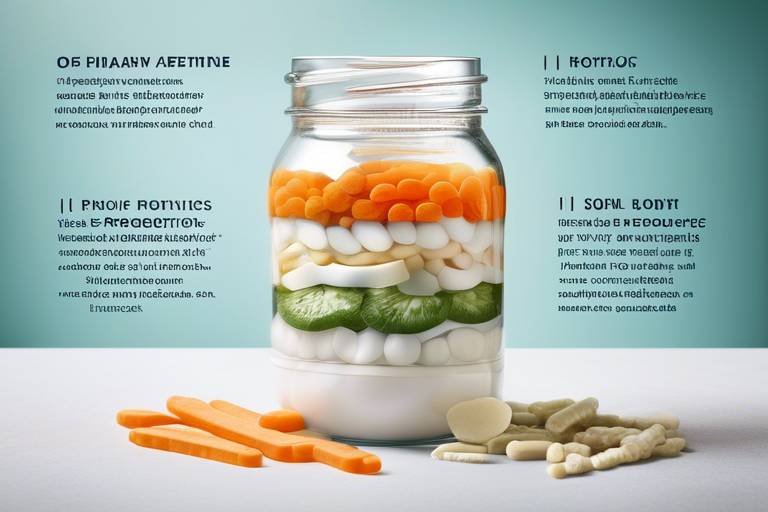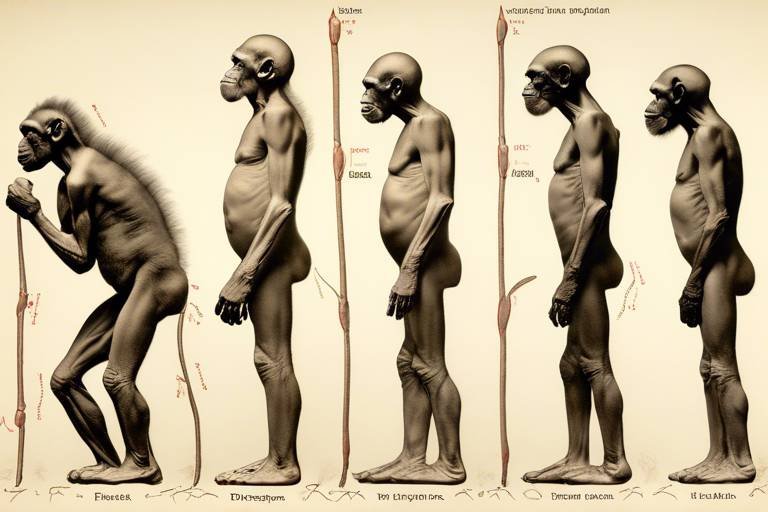The Chemistry of Cooking - Why Ingredients Matter
Have you ever wondered why some dishes taste so much better than others? The secret often lies in the chemistry of cooking. Each ingredient you use in your meal is like a tiny puzzle piece, and when combined correctly, they create a masterpiece that tantalizes your taste buds. Cooking isn't just about following a recipe; it's about understanding how ingredients interact on a molecular level. This article dives deep into the intricate relationship between chemistry and cooking, highlighting how ingredients work together to create flavor, texture, and nutritional value in our meals.
When you think about it, cooking is a lot like conducting an orchestra. Each ingredient plays its own unique note, and it’s the chef’s job to harmonize them into a delicious symphony. For instance, consider the role of acids and bases. These chemical properties can dramatically enhance flavors and alter textures. Imagine biting into a perfectly balanced vinaigrette, where the acidity of vinegar cuts through the richness of oil, creating a delightful dance of flavors in your mouth. Mastering these properties is essential for any chef looking to elevate their culinary game.
But the chemistry of cooking doesn't stop at acids and bases. One of the most fascinating processes to explore is the Maillard reaction, the science behind browning. This complex chemical reaction occurs when proteins and sugars in food are exposed to heat, resulting in that beautiful golden-brown crust we all love. Think about the difference between a pale piece of chicken and a perfectly seared one; that rich, savory flavor is a direct result of the Maillard reaction at work. It’s like magic happening right in your kitchen, transforming ordinary ingredients into extraordinary dishes.
Temperature is another critical player in this culinary chemistry. Just as a musician needs to hit the right notes at the right time, a cook must control temperature to achieve optimal flavor development. For instance, did you know that cooking steak at a lower temperature for a longer time can yield a juicier result than a quick, high-heat sear? Understanding the ideal temperatures for different ingredients can make all the difference in your cooking outcomes. Here’s a quick guide:
| Ingredient | Optimal Cooking Temperature (°F) | Notes |
|---|---|---|
| Chicken | 165 | Ensure it’s cooked through to avoid foodborne illness. |
| Steak | 130-145 | Medium-rare to medium for best flavor. |
| Vegetables | 400-425 | Roasting brings out natural sweetness. |
However, many cooks struggle with temperature control, leading to overcooked or undercooked dishes. This is where understanding common pitfalls can significantly improve your culinary outcomes. For instance, not preheating your oven can result in uneven cooking, while cooking meat straight from the fridge can lead to a tough texture. By being aware of these mistakes, you can take proactive steps to ensure your dishes turn out perfectly every time.
Let’s not forget about baking, which is a science in its own right. Baking relies heavily on chemical reactions, where precise measurements and ingredient interactions determine the success of your baked goods. From the rise of bread to the fluffiness of cakes, understanding these principles is essential for any aspiring baker. The chemistry behind baking can be likened to a carefully choreographed dance; every step must be executed flawlessly to achieve the desired result.
In summary, the chemistry of cooking is a fascinating world where ingredients come together to create something much greater than the sum of their parts. By understanding the science behind cooking, you can unlock new flavors, textures, and experiences in your meals. So the next time you step into the kitchen, remember that you’re not just cooking; you’re performing a delicate balance of chemistry that can lead to culinary masterpieces.
- What is the Maillard reaction?
The Maillard reaction is a chemical process that occurs when proteins and sugars are heated, resulting in browning and the development of complex flavors.
- Why is temperature control important in cooking?
Temperature control is crucial because it affects the texture and flavor of the food, ensuring that dishes are cooked properly without being over or undercooked.
- What are some common emulsifiers used in cooking?
Common emulsifiers include egg yolks, mustard, and honey, which help to stabilize mixtures like dressings and sauces.

The Role of Acids and Bases
When it comes to cooking, the role of acids and bases is often underestimated. These two chemical properties can dramatically transform the flavors and textures of your favorite dishes. Think of acids as the bright, zesty notes in your cooking, while bases can add a depth and richness that rounds out a meal. Understanding how they interact can elevate your culinary game to new heights. For instance, a splash of lemon juice or vinegar can brighten up a heavy dish, cutting through the richness and adding a refreshing zing.
But what exactly do acids and bases do in cooking? Well, they can change the pH level of your ingredients, which in turn affects everything from flavor to texture. Acids, like vinegar and citrus, can tenderize meats by breaking down proteins, making them softer and more palatable. On the other hand, bases, such as baking soda, can create a more tender crumb in baked goods, giving them that perfect fluffy texture we all crave.
Let’s break it down further. Here are some common examples of how acids and bases play a role in cooking:
- Marinades: Acids in marinades help to tenderize meat while infusing it with flavor.
- Baking: The right balance of acids and bases is crucial for achieving the perfect rise in cakes and breads.
- Pickling: Acids are essential in the pickling process, preserving vegetables and enhancing their flavors.
Moreover, the balance between acids and bases can create a harmonious flavor profile. For example, a well-made vinaigrette combines oil (a neutral base) with vinegar (an acid) to create a dressing that’s both flavorful and versatile. The key is finding that sweet spot where the acidity complements the other ingredients without overpowering them.
In addition to flavor, the interaction between acids and bases can also affect color. For instance, adding an acid to a dish can brighten the color of vegetables, making them more visually appealing. Conversely, a base can dull colors, which is why it’s essential to understand when to use each one.
To sum it up, mastering the role of acids and bases in cooking isn’t just for professional chefs. With a little knowledge and experimentation, anyone can harness the power of these chemical properties to enhance their dishes. So, next time you're whipping up a meal, consider how you can use acids and bases to create a more dynamic flavor experience!

Maillard Reaction: The Science of Browning
The Maillard reaction is one of the most fascinating phenomena in the culinary world, and understanding it can truly elevate your cooking game. Imagine biting into a perfectly seared steak or a golden-brown loaf of bread; that rich, complex flavor you experience is largely due to this intricate chemical reaction. When proteins and sugars in food are exposed to heat, they undergo a series of reactions that create new flavor compounds, resulting in the delightful browning that we all love. This process not only enhances the taste but also contributes to the aroma and color of our food, making it visually appealing and appetizing.
But what exactly happens during the Maillard reaction? It all starts when heat is applied to food, typically at temperatures above 140°C (284°F). At this point, amino acids (the building blocks of proteins) react with reducing sugars, leading to the formation of various complex compounds. These compounds are responsible for the rich flavors and aromas that characterize many cooked foods. It's like a flavor explosion happening right before your eyes! The Maillard reaction is not just a single event; it’s a cascade of reactions that can produce thousands of different flavor molecules, each contributing to the unique profile of a dish.
Temperature plays a crucial role in the Maillard reaction. If the temperature is too low, the reaction will occur slowly, resulting in a less pronounced browning and flavor. Conversely, if the temperature is too high, it can lead to burnt flavors and undesirable textures. Therefore, finding the optimal temperature is key. Here’s a quick look at the ideal temperature ranges for different types of foods:
| Food Type | Optimal Temperature (°C) | Flavor Development |
|---|---|---|
| Meats | 150-200 | Rich umami flavors |
| Breads | 180-220 | Sweet, nutty notes |
| Vegetables | 160-190 | Caramelized sweetness |
However, many home cooks often stumble when it comes to temperature control, leading to either overcooked or undercooked dishes. Understanding the common pitfalls can significantly improve your culinary outcomes. For instance, rushing the cooking process by cranking up the heat might seem like a good idea, but it can lead to uneven cooking. Instead, patience is key; allowing food to cook at the right temperature will yield the best results. Additionally, using a thermometer can help you monitor the internal temperature of meats, ensuring that they reach the perfect doneness without sacrificing flavor.
In summary, the Maillard reaction is a cornerstone of cooking that brings depth, color, and flavor to our meals. By mastering the science behind this reaction, you can transform ordinary ingredients into extraordinary dishes. So, the next time you hear that sizzle in the pan or see that beautiful golden crust forming, remember, it’s not just cooking—it’s chemistry in action!
- What is the Maillard reaction? The Maillard reaction is a complex chemical process that occurs when proteins and sugars in food react under heat, resulting in browning and enhanced flavors.
- Why is temperature important in the Maillard reaction? Temperature affects the rate and extent of the Maillard reaction; too low can result in minimal browning, while too high can cause burning.
- Can I achieve the Maillard reaction with all cooking methods? While grilling, roasting, and frying are ideal for this reaction, methods like boiling or steaming do not reach the necessary temperatures for browning.

Temperature's Impact on Flavor Development
When it comes to cooking, temperature isn't just a number; it's a vital player in the flavor game. Imagine cooking a steak: if you toss it on a grill that's too hot, you might end up with a charred exterior and an undercooked center. This is where the magic of temperature comes into play, influencing not just how food looks, but how it tastes. The right temperature can unlock a symphony of flavors, while the wrong one can leave you with a culinary disaster.
One of the most fascinating aspects of temperature in cooking is its role in the Maillard reaction, a chemical process that occurs when proteins and sugars in food react under heat. This reaction is responsible for the rich, savory flavors we associate with grilled meats, roasted vegetables, and even baked goods. For instance, when you roast a chicken, the high heat caramelizes the sugars and browns the proteins, creating that delicious crust that makes your mouth water. But if you’re cooking at too low a temperature, you might miss out on that exquisite flavor development, resulting in a bland dish.
Now, let's talk specifics. Different ingredients require different temperatures to reach their full flavor potential. For example, vegetables like onions and garlic benefit from a gentle sautéing at medium heat to develop their sweetness, while meats often need higher temperatures to achieve that coveted sear. Here’s a quick reference table to illustrate optimal cooking temperatures for various ingredients:
| Ingredient | Optimal Cooking Temperature (°F) | Cooking Method |
|---|---|---|
| Steak | 450-500 | Grilling |
| Chicken | 375-400 | Roasting |
| Onions | 300-350 | Sautéing |
| Bread | 350-375 | Baking |
However, it's not just about hitting that ideal temperature; it’s also about maintaining it. Many home cooks struggle with this, leading to inconsistent results. For example, if you’re baking bread and open the oven door too frequently, you might lower the temperature, which can prevent the bread from rising properly. Similarly, if you crank the heat up too high while frying, you risk burning the outside while leaving the inside raw. Understanding how to control and maintain temperature is crucial for achieving the best flavor and texture in your dishes.
In summary, temperature is more than just a guideline in cooking; it’s a fundamental element that can make or break your culinary creations. By mastering the art of temperature control, you can elevate your cooking to new heights, unlocking flavors that will tantalize your taste buds and impress your guests. So, the next time you step into the kitchen, remember: the right temperature is your secret ingredient for success!
- What is the Maillard reaction?
The Maillard reaction is a chemical process that occurs when proteins and sugars in food react under heat, creating complex flavors and browning. - How does temperature affect cooking?
Temperature influences the rate of chemical reactions in cooking, impacting flavor development, texture, and overall dish quality. - What are optimal cooking temperatures for meats?
For best results, steak should be cooked at 450-500°F, and chicken at 375-400°F. - Why is temperature control important in baking?
Temperature control is crucial in baking because it ensures even cooking and proper rising of baked goods, leading to better texture and flavor.

Optimal Temperatures for Different Ingredients
When it comes to cooking, understanding the optimal temperatures for various ingredients can be the difference between a dish that delights the palate and one that disappoints. Each ingredient has its own unique characteristics that respond differently to heat. For instance, proteins like meat and fish require specific temperatures to achieve the perfect doneness without sacrificing flavor or texture. Cooking meat at too high a temperature can lead to a dry and tough outcome, while undercooking it can pose health risks. Generally, the ideal cooking temperatures for meats are:
| Type of Meat | Optimal Cooking Temperature (°F) |
|---|---|
| Beef (Medium Rare) | 130-135 |
| Pork | 145 |
| Chicken | 165 |
| Fish | 145 |
On the other hand, vegetables also have their sweet spots when it comes to cooking temperatures. For instance, steaming broccoli at around 200°F helps retain its vibrant color and nutrients, while roasting it at a higher temperature, around 425°F, caramelizes the sugars, enhancing its flavor. This concept of temperature control extends beyond just meats and vegetables; it also applies to baking, where precision is key. For example, yeast doughs typically rise best at temperatures between 75°F and 85°F, allowing the yeast to activate without cooking it.
Moreover, the temperature at which you cook can also influence the texture of your dishes. For example, if you’re making a delicate sauce, it’s crucial to keep the heat low to avoid breaking the emulsion. On the contrary, if you want to achieve a crispy skin on your roasted chicken, a higher temperature is essential. Understanding these nuances can elevate your cooking to new heights, allowing you to create dishes that not only taste great but also have the right mouthfeel.
In summary, mastering the optimal temperatures for different ingredients is a fundamental skill in the kitchen. It requires a bit of practice and attention, but the rewards are well worth the effort. So next time you’re in the kitchen, remember that cooking is as much about science as it is about art. Embrace the chemistry of cooking, and you’ll find that your dishes will not only be delicious but also perfectly executed!

Common Mistakes in Temperature Control
When it comes to cooking, temperature control is often the unsung hero of culinary success. Many home cooks, in their eagerness to whip up a delicious meal, overlook the critical role that temperature plays. One of the most common mistakes is not preheating the oven or pan adequately. Imagine trying to bake a cake in a cold oven—it's like trying to run a marathon in flip-flops! The result? A cake that’s unevenly cooked, with a texture that leaves much to be desired.
Another frequent pitfall is assuming that all stovetops heat the same way. Different burners can have varying heat outputs, and not adjusting your cooking temperature accordingly can lead to disaster. For instance, if you’re sautéing vegetables on a low flame, you might end up with soggy, unappetizing results instead of that delightful crispiness you were aiming for. It’s essential to get familiar with your kitchen equipment and adjust your cooking methods to suit them.
Moreover, many cooks tend to open the oven door too frequently to check on their dishes. While curiosity is natural, every time you peek inside, you let out heat, which can significantly alter the cooking process. Think of it like opening a window in the middle of winter; the room cools down, and it takes time to warm back up. Instead, try to resist the urge to check too often and trust your timers!
Lastly, a common error is not using a food thermometer. Relying solely on visual cues can be misleading. For example, a piece of chicken may look beautifully golden on the outside but could be dangerously undercooked on the inside. Using a thermometer ensures that your food reaches the proper internal temperature, providing both safety and the best flavor. Here’s a quick reference table for safe cooking temperatures:
| Food Item | Safe Cooking Temperature (°F) |
|---|---|
| Chicken (whole) | 165 |
| Beef (ground) | 160 |
| Pork (whole) | 145 |
| Fish | 145 |
By being mindful of these common mistakes, you can significantly improve your cooking outcomes and enjoy dishes that are not only safe to eat but also bursting with flavor. Remember, cooking is as much a science as it is an art, and mastering the temperature aspect is key to becoming a culinary maestro!
- What is the best way to check if my oven is at the right temperature? A reliable oven thermometer can help you ensure that your oven heats accurately.
- How can I avoid overcooking my food? Use a timer and check the internal temperature with a food thermometer to avoid overcooking.
- Is it necessary to preheat my pan before cooking? Yes, preheating your pan helps achieve better browning and cooking results.

Applications in Baking
Baking is much more than just mixing flour, sugar, and eggs; it's a fascinating interplay of chemistry and artistry that transforms simple ingredients into delightful treats. When you step into a kitchen to bake, you're essentially stepping into a laboratory where precise measurements and reactions dictate the outcome of your culinary creations. For instance, when you combine flour with water and yeast, you're not just creating dough; you're initiating a complex series of chemical reactions that will ultimately lead to the delightful rise and texture of bread. Isn’t it amazing how something as simple as yeast can turn a flat mixture into a fluffy loaf?
One of the key principles in baking is understanding the role of different ingredients. For example, the protein in flour, when combined with water, forms gluten—a web-like structure that gives bread its chewiness. On the other hand, the sugar not only sweetens but also contributes to browning through the Maillard reaction, enhancing flavor and appearance. This is why a perfectly baked loaf has that golden crust that beckons you to take a bite. The science behind baking is akin to conducting an orchestra; each ingredient plays its part in harmony to create a delicious symphony of flavors and textures.
Moreover, the temperature at which you bake can dramatically affect the final product. Different baked goods require different baking temperatures to achieve the desired results. For instance, cookies typically bake at higher temperatures to promote quick browning, while cakes often require gentler heat to ensure they rise evenly without burning. This is why it's crucial to preheat your oven and use an oven thermometer to ensure accuracy. A small deviation in temperature can mean the difference between a light, airy cake and a dense, sunken disaster.
| Baked Good | Optimal Baking Temperature (°F) | Typical Baking Time (minutes) |
|---|---|---|
| Cakes | 350 | 25-35 |
| Cookies | 375 | 10-15 |
| Bread | 425 | 25-30 |
| Pies | 375 | 45-60 |
Another crucial aspect of baking is the role of leavening agents. These ingredients, such as baking powder and baking soda, create gas bubbles in the batter, causing it to rise. Understanding how and when to use these agents can make or break your baking endeavors. For example, baking soda needs an acid to activate, while baking powder contains both an acid and a base, making it versatile for various recipes. It's like knowing the right key to unlock the door to perfect baked goods!
In conclusion, the applications of chemistry in baking are vast and intricate. From the way ingredients interact to the precise temperatures required, every detail matters in creating that perfect baked good. So, the next time you whip up a batch of cookies or a loaf of bread, remember: you’re not just baking; you’re conducting a delicious experiment!
- What is the best way to measure flour for baking? It's best to spoon flour into a measuring cup and level it off with a knife to avoid packing it down, which can lead to using too much flour.
- Why is it important to preheat the oven? Preheating ensures that your baked goods start cooking at the right temperature, which is crucial for proper rising and browning.
- Can I substitute baking powder for baking soda? Not directly, as they have different chemical properties. However, you can use baking powder as a substitute by using about three times the amount of baking powder as you would baking soda.

The Importance of Emulsification
Emulsification is one of those magical processes in cooking that often goes unnoticed, yet it plays a pivotal role in creating the textures and flavors we love in our favorite dishes. Imagine trying to mix oil and water; they just don't get along, right? This is where emulsification steps in, a technique that allows these two immiscible liquids to blend into a harmonious mixture. It's like a culinary peace treaty! By understanding and mastering emulsification, cooks can create stable mixtures that elevate their dishes to new heights.
Why does emulsification matter so much? Well, think about your favorite salad dressing. If you've ever made one at home, you know that without proper emulsification, it can quickly separate into a sad puddle of oil and vinegar at the bottom of the bowl. A well-emulsified dressing, on the other hand, clings beautifully to your greens, enhancing each bite with flavor and texture. This principle extends beyond dressings to sauces, soups, and even baked goods, where the right blend can make all the difference.
At its core, emulsification is about creating a stable mixture of two substances that typically refuse to mix. This is achieved by using an emulsifier, a substance that helps to stabilize the mixture. Some common emulsifiers include:
- Egg Yolks: Rich in lecithin, a natural emulsifier that binds oil and water.
- Mustard: Not only does it add flavor, but it also acts as a powerful emulsifier.
- Honey: This sweetener can help stabilize dressings and sauces.
In professional kitchens, chefs often rely on techniques such as whisking, blending, or using a food processor to achieve the perfect emulsion. The process typically involves slowly adding the oil to the liquid while whisking vigorously, which helps to disperse the oil into tiny droplets, allowing it to mix seamlessly with the water-based component. It's like creating a tiny universe of flavor in a single bowl!
Understanding emulsification not only enhances flavor but also improves the texture of dishes. A well-emulsified sauce can have a creamy, luxurious mouthfeel that makes it irresistible. In contrast, an improperly emulsified sauce can feel greasy or watery, leaving diners disappointed. This is why chefs take the time to perfect their emulsification techniques; it’s all about delivering the best possible experience on the plate.
To sum it up, emulsification is a fundamental aspect of cooking that transforms the way we perceive and enjoy food. Whether you’re dressing a salad, preparing a sauce, or baking a cake, mastering the art of emulsification can lead to remarkable results. So next time you whip up a vinaigrette or a creamy sauce, remember the science behind it and the importance of that magical blend!
Q: What is emulsification?
A: Emulsification is the process of mixing two immiscible liquids, such as oil and water, to create a stable mixture. This is often achieved using an emulsifier.
Q: Why do some dressings separate?
A: Dressings separate when they are not properly emulsified, meaning the oil and water components have not blended together effectively.
Q: What are some common emulsifiers?
A: Common emulsifiers include egg yolks, mustard, and honey, which help stabilize mixtures of oil and water.
Q: How can I improve my emulsification technique?
A: To improve emulsification, try adding the oil slowly while whisking vigorously, ensuring that the oil droplets are small enough to mix uniformly with the liquid.

Techniques for Successful Emulsification
Emulsification is an essential technique in cooking that allows two immiscible liquids, like oil and water, to blend together into a smooth and stable mixture. This process is not only crucial for creating delightful sauces and dressings but also enhances the overall flavor and texture of many dishes. To achieve successful emulsification, there are several techniques that culinary enthusiasts can master. One of the most effective methods is to use a whisk or an immersion blender. The vigorous motion helps to break down the oil droplets, allowing them to disperse evenly throughout the water phase, thereby creating a stable emulsion.
Another technique involves the gradual addition of the oil to the water-based ingredient while whisking continuously. This slow incorporation allows the oil to emulsify more effectively, preventing separation. Think of it like introducing a new friend to a group; if you do it gradually, they'll feel more comfortable and fit in better! In addition to these methods, temperature plays a significant role in emulsification. For instance, using room temperature ingredients can help achieve a more stable emulsion, as colder ingredients tend to solidify fats and create an unstable mixture.
Moreover, understanding the role of emulsifiers can significantly enhance your emulsification skills. Emulsifiers are substances that help stabilize mixtures by reducing the surface tension between the two liquids. Common emulsifiers include:
- Egg Yolks: Rich in lecithin, a natural emulsifier, egg yolks are often used in mayonnaise and hollandaise sauce.
- Mustard: Not only does it add flavor, but mustard also contains emulsifying properties that help keep oil and vinegar together in salad dressings.
- Honey: This sweetener acts as a natural emulsifier, particularly in vinaigrettes.
By incorporating these techniques and understanding the science behind emulsification, cooks can elevate their culinary creations. Whether you're whipping up a classic vinaigrette or a creamy sauce, mastering emulsification will ensure that your dishes are not only delicious but also visually appealing, with a smooth and cohesive texture.
Q: What is emulsification?
A: Emulsification is the process of mixing two immiscible liquids, such as oil and water, to create a stable mixture.
Q: Why are emulsifiers important?
A: Emulsifiers help to stabilize emulsions by reducing the surface tension between the liquids, preventing them from separating.
Q: Can I emulsify without an electric mixer?
A: Absolutely! You can achieve emulsification by hand using a whisk. It may take a bit more effort, but it's entirely possible.
Q: What temperature should my ingredients be for emulsification?
A: Using room temperature ingredients is ideal for emulsification, as it helps to create a more stable mixture.

Common Emulsifiers in Cooking
This article explores the intricate relationship between chemistry and cooking, highlighting how ingredients interact to create flavor, texture, and nutritional value in our meals.
Understanding how acids and bases affect cooking can enhance flavors and alter textures, making it essential for chefs to master these chemical properties in their culinary practices.
The Maillard reaction is a complex chemical process that occurs during cooking, responsible for the browning of foods and the development of rich flavors, crucial for many beloved dishes.
Temperature plays a vital role in the Maillard reaction, influencing the rate of browning and the depth of flavor in cooked foods, making it a critical factor in successful cooking.
Different ingredients require specific temperatures to achieve ideal flavor and texture, emphasizing the importance of precision in cooking techniques for the best results.
Many cooks struggle with temperature control, leading to overcooked or undercooked dishes; understanding these pitfalls can significantly improve culinary outcomes.
Baking is a science that relies heavily on chemical reactions, where precise measurements and ingredient interactions determine the success of baked goods, making it essential to grasp these principles.
Emulsification is a crucial process in cooking that combines ingredients like oil and water, creating stable mixtures essential for sauces, dressings, and other culinary applications.
Mastering emulsification techniques, such as whisking and blending, can elevate dishes by ensuring that flavors and textures are well-integrated, resulting in a more enjoyable eating experience.
When it comes to creating stable emulsions, understanding common emulsifiers is key. These ingredients not only help blend oil and water but also enhance the overall flavor and texture of a dish. Some of the most popular emulsifiers include:
- Egg Yolks: Rich in lecithin, egg yolks are perhaps the most famous emulsifier. They are essential in classic sauces like hollandaise and mayonnaise.
- Mustard: This condiment not only adds a kick to dishes but also acts as a powerful emulsifier, helping to stabilize vinaigrettes and sauces.
- Honey: Apart from its natural sweetness, honey can serve as an emulsifier in dressings, helping to blend oil and vinegar smoothly.
- Milk and Cream: The proteins and fats in dairy products can help stabilize emulsions, making them perfect for creamy dressings and sauces.
These emulsifiers work by reducing the surface tension between the oil and water, allowing them to mix more easily. For instance, when you whisk egg yolks into a vinaigrette, the lecithin in the yolks wraps around the oil droplets, preventing them from separating. This is why a good emulsifier is often the secret weapon in the kitchen, allowing cooks to create delicious and stable mixtures that enhance their culinary creations.
Q: What is emulsification?
A: Emulsification is the process of mixing two liquids that normally don't mix, like oil and water, to create a stable mixture.
Q: Can I use substitutes for common emulsifiers?
A: Yes! While egg yolks and mustard are traditional emulsifiers, alternatives like aquafaba (chickpea water) can also work for vegan emulsions.
Q: Why do some emulsions break?
A: Emulsions can break if the ingredients are not mixed properly or if the temperature is too high or low. It's crucial to add the oil slowly and whisk continuously.
Frequently Asked Questions
- What is the role of acids and bases in cooking?
Acids and bases play a crucial role in cooking by affecting the flavor and texture of food. For instance, adding an acid like lemon juice can brighten flavors and help tenderize meats, while bases can enhance browning and flavor development. Understanding these properties can elevate your culinary skills to new heights!
- How does the Maillard reaction impact flavor?
The Maillard reaction is a fascinating chemical process that occurs when proteins and sugars in food react under heat, creating that delicious browning and rich flavors we love. This reaction is essential for many of our favorite dishes, such as seared meats and toasted bread, making it a key player in the kitchen!
- What temperatures are best for cooking different ingredients?
Each ingredient has its own optimal cooking temperature to achieve the best flavor and texture. For example, delicate proteins like fish should be cooked at lower temperatures to avoid drying out, while tougher cuts of meat benefit from higher heat to break down collagen. Precision is key!
- What are common mistakes in temperature control?
Many cooks struggle with temperature control, leading to dishes that are either overcooked or undercooked. Common mistakes include not preheating the oven properly or not using a thermometer to check doneness. By mastering temperature control, you can significantly improve your cooking outcomes!
- Why is emulsification important in cooking?
Emulsification is vital because it allows for the stable mixing of ingredients that typically don't combine well, like oil and water. This process is essential for creating smooth sauces and dressings, enhancing both flavor and texture in your dishes. Without emulsification, your sauces might separate and lose their intended taste!
- What techniques can help with emulsification?
Mastering techniques like whisking, blending, or using an immersion blender can greatly improve your emulsification skills. These methods help to incorporate air and create stable mixtures, ensuring that flavors meld perfectly for a delightful eating experience!
- What are some common emulsifiers used in cooking?
Common emulsifiers include egg yolks, mustard, and honey. These ingredients help stabilize mixtures, allowing for a creamy and cohesive texture in sauces and dressings, making your culinary creations not only delicious but visually appealing too!



















